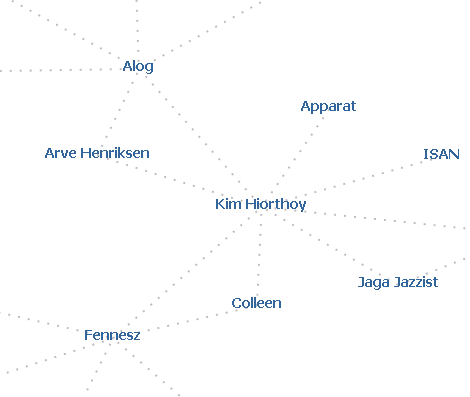| Posted by kyle on November 5, 2006 11:11 PM | bookmark / share: |
|
I've received a lots of great comments and e-mails about the music recommendations demo I posted a week or so ago. But a number of you mentioned that the recommendations were a little funny. Questions and observations so far:
- Theivery Corporation is the center of the universe! Every album ever released is 3 or fewer hops away from a Theivery Corporation album.
- Why is every album I search for related to Beck? or Moby? or Neil Young? Though I'll point out, the man has been in almost every band that's ever released an album. Seriously, that album by the Back Street Boys and Young is one of my favorites!
- How is this tool useful if the only related albums to my search are by the same artist?
Right. So ... There's a lesson here:
There's always a little bit of "magic" in a mashup.
The music recommendations demo gets album relationships from Amazon.com's E-commerce API. Similarity is based on buying patterns, which apparently lead to some unexpected or disappointing results. So I decided to try out an alternative.
I worked up a quick mashup using the Audioscrobbler (Last.fm) API for Artist-to-Artist recommendations. Audioscrobbler uses the listening patterns of it's users to determine relationships. Unfortunately, the images served up with this API aren't especially useful in identifying artists, especially when scaled down. So this demo is currently text-only. If you're interested, the demo could be extended to grab an album image from Amazon.com. I tried this and bailed out quickly because it added a lot of latency to the addition of new nodes, but you may be able to cut this down using an image cache.
Oh, one more thing! These demos don't work so well in ie7. This isn't an issue with the JSViz 0.3.1 API. I'll fix the demos when I have some spare time. Thanks for all the feedback. It's useful in driving this project.

Comments
When will these demo's work in IE7? I get a lot of javascript errors in IE7 now when I try the demo's.
I'm trying to make my own application with JSViz, but with IE7 I get a lot of errors and I don't know why.
Keep up the good work!
Posted by: Mike | December 15, 2006 4:54 PM
Hi,
I saw your toturials regarding building grpahs on the web and those are really impressing!
do you have a page where I can download a whole example (project) that I can run (like the wordnet?).
can I integrate your code into an ASP.net or is working only with Java?
do you have an example of integrating this kind of graphes into ASP.NET?
does this technology allows add a right-click menu to each element on the web graph?
is that an open source free to use?
thanks a lot in advance, you are the best!
Assaf.
Posted by: assaf | December 31, 2006 4:46 AM
Mike, I'm wrapping up the next release of JSViz in about a week. These IE7 bugs are targetted for the release. I'll be posting about it as soon as it's available.
Posted by: Kyle Scholz | January 7, 2007 2:55 PM
Assaf,
Thanks for the compliments! I'm currently putting together a site to
make working with JSViz easier -- At the moment, I don't have a
download package, but I'm hoping to get to this over the next couple
of weeks. In the meantime, you can access the individual JSViz files
from this blog post:
http://www.kylescholz.com/blog/2006/10/jsviz_031_available.html
JSViz currently operates 100% on the client side, in JavaScript, so
you should be able to integrate it with any server side platform
(.NET, Java, PERL/PHP, etc.). The easiest place to start is to make a
REST interface that will produce the desired data from an HTTP
request. The most recent examples on my website show how to populate a
graph with data from a REST interface.
Regarding right-click menus, you can add custom event handlers to the
nodes in your graph just like any HTML or SVG elements in JavaScript.
In my examples, I show how to include some "mousedown" functionality.
You can extend this to add your own right-click menus.
All JSViz code is free to use and modify under a Creative Commons
Attribution License.
Good luck Assaf and have fun!
Posted by: Kyle Scholz | January 7, 2007 2:58 PM